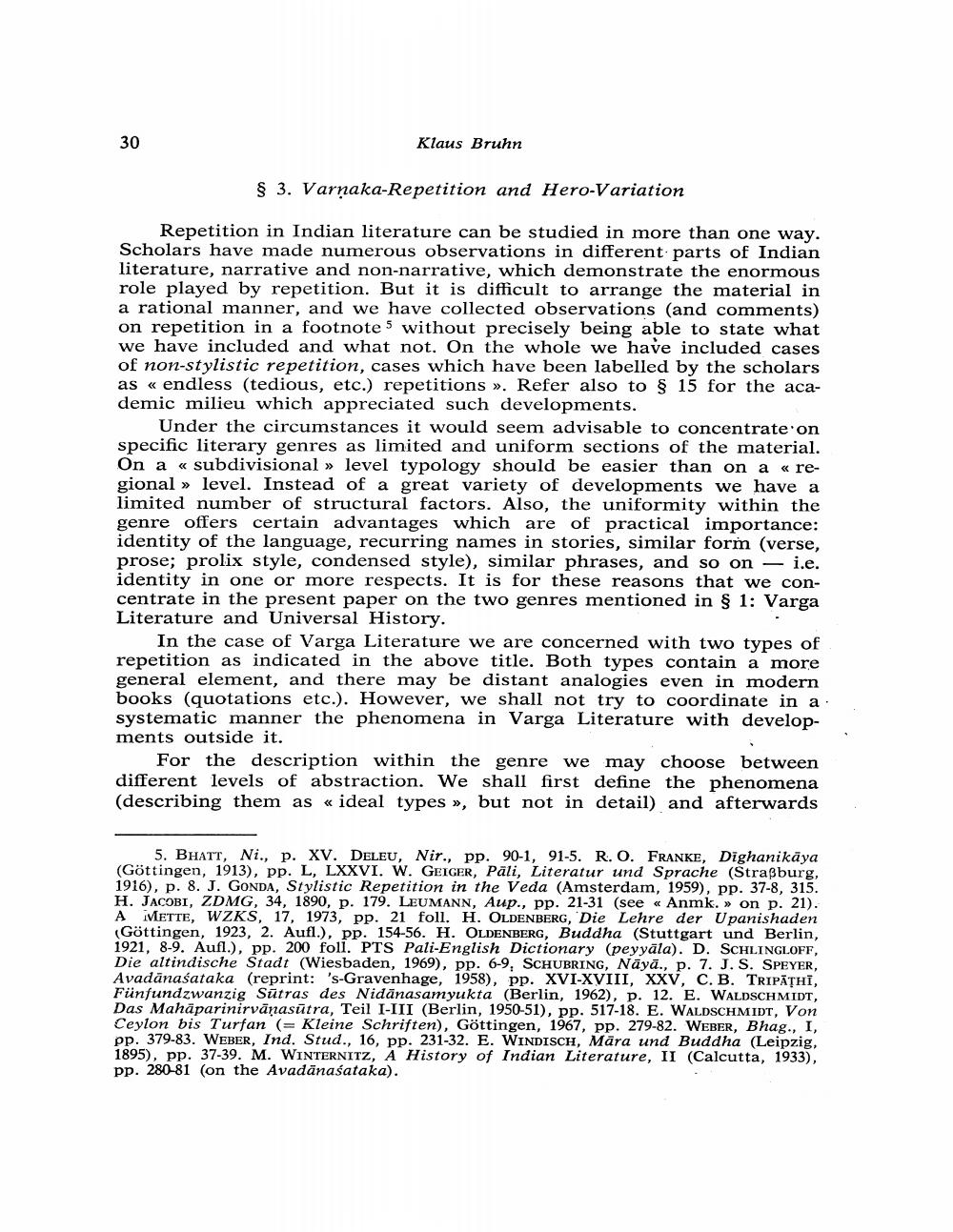________________
30
Klaus Bruhn
§ 3. Varnaka-Repetition and Hero-Variation
Repetition in Indian literature can be studied in more than one way. Scholars have made numerous observations in different parts of Indian literature, narrative and non-narrative, which demonstrate the enormous role played by repetition. But it is difficult to arrange the material in a rational manner, and we have collected observations (and comments) on repetition in a footnote 5 without precisely being able to state what we have included and what not. On the whole we have included cases of non-stylistic repetition, cases which have been labelled by the scholars as « endless (tedious, etc.) repetitions ». Refer also to § 15 for the academic milieu which appreciated such developments.
Under the circumstances it would seem advisable to concentrate on specific literary genres as limited and uniform sections of the material. On a « subdivisional »> level typology should be easier than on a «regional >> level. Instead of a great variety of developments we have a limited number of structural factors. Also, the uniformity within the genre offers certain advantages which are of practical importance: identity of the language, recurring names in stories, similar form (verse, prose; prolix style, condensed style), similar phrases, and so on — i.e. identity in one or more respects. It is for these reasons that we concentrate in the present paper on the two genres mentioned in § 1: Varga Literature and Universal History.
In the case of Varga Literature we are concerned with two types of repetition as indicated in the above title. Both types contain a more general element, and there may be distant analogies even in modern books (quotations etc.). However, we shall not try to coordinate in a systematic manner the phenomena in Varga Literature with developments outside it.
For the description within the genre we may choose between different levels of abstraction. We shall first define the phenomena (describing them as « ideal types », but not in detail) and afterwards
5. BHATT, Ni., p. XV. DELEU, Nir., pp. 90-1, 91-5. R. O. FRANKE, Dighanikaya (Göttingen, 1913), pp. L, LXXVI. W. GEIGER, Pāli, Literatur und Sprache (Straßburg, 1916), p. 8. J. GONDA, Stylistic Repetition in the Veda (Amsterdam, 1959), pp. 37-8, 315. H. JACOBI, ZDMG, 34, 1890, p. 179. LEUMANN, Aup., pp. 21-31 (see « Anmk. »> on p. 21). A METTE. WZKS, 17, 1973, pp. 21 foll. H. OLDENBERG, Die Lehre der Upanishaden (Göttingen, 1923, 2. Aufl.), pp. 154-56. H. OLDENBERG, Buddha (Stuttgart und Berlin, 1921, 8-9. Aufl.), pp. 200 foll. PTS Pali-English Dictionary (peyyāla). D. SCHLINGLOFF, Die altindische Stadt (Wiesbaden, 1969), pp. 6-9, SCHUBRING, Nāyā., p. 7. J.S. SPEYER, Avadānaśataka (reprint: 's-Gravenhage, 1958), pp. XVI-XVIII, XXV, C. B. TRIPĀȚHĪ, Fünfundzwanzig Sūtras des Nidānasamyukta (Berlin, 1962), p. 12. E. WALDSCHMIDT, Das Mahäparinirvāṇasūtra, Teil I-III (Berlin, 1950-51), pp. 517-18. E. WALDSCHMIDT, Von Ceylon bis Turfan (= Kleine Schriften), Göttingen, 1967, pp. 279-82. WEBER, Bhag., I, pp. 379-83. WEBER, Ind. Stud., 16, pp. 231-32. E. WINDISCH, Māra und Buddha (Leipzig, 1895), pp. 37-39. M. WINTERNITZ, A History of Indian Literature, II (Calcutta, 1933), pp. 280-81 (on the Avadānaśataka).




